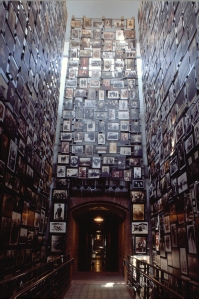Art is a fundamental part of our social fabric, touching upon all elements of the human experience. Keeping in mind current events, I though we could look at ways in which art has been used to help both the public and veterans of war understand, remember and heal.
(Please note, this is not a pro or anti war post, instead it is a look at how art is part of the public setting and how art can contribute to our understanding and experiences with war.)Protest
In the U.S.we commonly think of the late 1960’s early 1970’s as a time when war protest songs were popular. However, music has commonly been a form of voicing protest against war. The song “I Didn’t Raise My Boy To Be A Soldier” (1915) was written as part of the pacifist movement during WWI.
I Didn’t Raise My Boy To Be A Soldier “I didn’t raise my boy to be a soldier,
I brought him up to be my pride and joy,
Who dares to place a musket on his shoulder,
To shoot some other mother’s darling boy?
Let nations arbitrate their future troubles,
It’s time to lay the sword and gun away,
There’d be no war today,
If mother’s all would say,
“I didn’t raise my boy to be a soldier.”
Song continue to be a way to voice protest, this list of protest songs of the 1980’s (not all about war) from a wide range of artists may include a few old favorites.
Promote
Art has also been used in messaging promoting and supporting war. Poster art, an art form that is easily accessible to a wide population, has commonly been used to depict a pro-war stance. The Nazi party made use of poster art to promote new ideas and ideals . During the Russian Revolution (1917 to 1920) poster art was also used to encourage public support.
Film has also been used as a medium used to garner support of war. The U.S. Office of War Information, established in1942, created a manual for Hollywood directors to influence film making. In terms of more current films, some have called Saving Private Ryan and Black Hawk Down are pro-war films.
Document
Art can be a means of capturing the experience of serving in the militaryor being in battle. Michael Fay served as an official war artist with the US Marines and captured his experiences while stationed in Afghanistan .
Poetry has also been used to document the experience of war. During the first World War a number of solders wrote verse, both patriotic and critical, documenting their experience. Wilfred Owen’s (WWI soldier) poem Dulce Et Decorum Est (Latin for “It is sweet and right”) depits the horrors of trench warfare.
Memorial
Art serves to memorialize and pay tribute to events of war, the fallen and those who have lived on. Kathe Kollwitz (1867-1945, German) created early woodcuts and drawings that reflected her compassion toward the working poor, the suffering and the sick. After her son Peter’s death in WWI she created The Grieving Parent, two statues that now flank the entrance to the Vladslo German war cemetery where her son lay buried.
The Holocaust Museum serves as a memorial to those lost in the and works to educate and maintain awareness of this event in world history. Having had opportunity to visit this museum I can say that it is hard not to be moved by the exhibits. The Tower of Faces truly is a breath taking exhibit, beautiful and sorrowful all at once.
Heal
What I think is most extraordinary about art is the role it plays in helping us makes sense of painful or difficult emotions and experiences. Art allows us to explore our own feelings, share those feelings and begin the healing process.
In recent years art has been effectively used as a tool to help returning veterans in the healing process with the Veterans Administration and heath care centers offer therapeutic art activities.
Other art programs helping veterans to heal include The Combat Paper Project, an innovative project where veterans turn their worn out uniforms into paper, then create works of art and the Theater of War, which uses drama to work through emotions and share experiences.
The International Art Therapy Alliance has further information on art therapy and the military.





